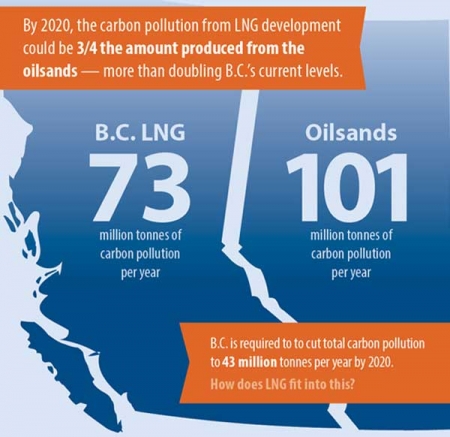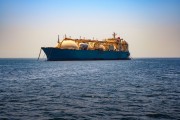This month, provincial MLAs are preparing for the upcoming legislative session, in which they will debate rules for carbon pollution and taxes for liquefied natural gas (LNG) development.
The connection between LNG development and carbon pollution is significant. And just how the government chooses to manage both issues will have serious long-term implications for the province, and the country.
Last year, Minister of Natural Gas Development Rich Coleman was asked on CBC’s Early Edition what B.C.’s LNG plans could mean for the province’s climate targets. His response: “Meeting our goals will be a challenge.”
If you’re wondering how big that challenge may be, there are two things you should know. The first is that carbon pollution from this industry could be extremely large, nearly as much as the oilsands in Alberta produce. The other is that B.C. can choose to make the impact much smaller.
To view the complete infographic, click here.
The B.C. government is investing time and resources in promoting extensive LNG development. In order to meet their annual revenue hopes of more than $4 billion, the province will need to export four to six trillion cubic feet of shale gas per year by 2020. Producing that much gas would require five to seven LNG facilities and over 10,000 wells with the accompanying network of roads, pipelines, compressors and gas processing plants.
The Pembina Institute estimates that even the lower end of that development scenario would produce a staggering 73 million tonnes of carbon pollution per year by 2020. For comparison, the oilsands are currently Canada’s fastest-growing source of climate pollution — but by 2020, B.C.’s LNG plans would produce three-quarters as much carbon pollution if development proceeds as hoped.
For a province often cited as one of the greenest in Canada, it’s a profound disconnect.
Digging into the numbers
The carbon pollution considered here refers to LNG development in B.C. This includes pollution from extracting and processing the natural gas, likely from shale gas fields in northeastern B.C., transporting the gas to the LNG facilities on the coast, then liquefying and storing the LNG until it is loaded onto LNG carriers (tankers). This doesn’t include carbon pollution generated from burning this gas in Asia, which could produce more than 200 million additional tonnes of carbon pollution per year.
Producing 73 million tonnes or more of carbon pollution from a single industry in B.C. means the province will miss its legally binding target for carbon reductions. The law requires the annual carbon pollution from all activities (transportation, buildings, agriculture, forestry and other industry) to be below 43 million tonnes by 2020, and below 13 million tonnes by 2050.
The B.C. government could choose to alter or ignore the carbon reduction targets, as other governments have done, or add in special accounting for LNG. But these targets represent B.C.’s commitment to contribute to global climate solutions. And the evidence is mounting of the real-world impacts that repeatedly missing reduction targets can have. For B.C., the impacts of climate change include declining fisheries, flooded coastal communities and increasingly vulnerable forests.
Fortunately, walking away from B.C.’s climate commitments isn’t the only option. Decisions made about LNG development in 2014 could put B.C. on a lower-carbon development path.
A different path forward
Carbon pollution by the numbers (in carbon dioxide equivalent):
59 million tonnes: B.C.’s total carbon pollution in 2011 (all sectors of economy)
64 million tonnes: B.C.’s total carbon pollution in 2020, (without extensive LNG development*)
73 million tonnes: B.C.’s carbon pollution from extensive LNG development by 2020
137 million tonnes: B.C.’s total carbon pollution in 2020, with extensive LNG development
43 million tonnes per year, or less: B.C.’s carbon pollution target in 2020
13 million tonnes per year, or less: B.C.’s carbon pollution target in 2050
* Based on Environment Canada report: Canada’s Emissions Trends 2013, which captured only limited development of LNG (equivalent to 2 million tonnes of carbon pollution for all of Canada)
The Pembina Institute’s assumptions and approach to calculating carbon pollution can be found here.
Through its B.C. jobs plan, the government could choose to prioritize creating employment opportunities in lower-carbon sectors. For example, the clean energy sector is growing globally, with many countries choosing to invest in economic development through renewable energy industries. By working to grow other parts of the economy, B.C. would face less pressure to rapidly develop LNG for economic growth. Less LNG development means lower carbon pollution with jobs and GDP growth elsewhere.
The government could also be more selective, and choose to allow only the best LNG proposals to proceed. The carbon pollution from an LNG plant and associated shale gas extraction depends on decisions regarding timelines, siting, technology, and where the shale gas comes from. So choosing the LNG projects with the lowest carbon footprint — rather than as many projects as possible — would significantly reduce the projected jump in carbon pollution levels.
Depending on the priority placed on reducing B.C.’s carbon pollution, perhaps one LNG project would be approved. Maybe none. The B.C. government would be better equipped to make that choice if it undertook a strategic environmental assessment on LNG development, instead of only conducting separate environmental assessments for each proposed project.
Further, the technology choices LNG companies make could play an important role in reducing carbon pollution. How much renewable energy will be integrated into the design of the facilities? Will shale gas processing plants capture and store their carbon pollution? These decisions and others could be influenced by the standards and taxes the B.C. government sets for LNG development. Building on the success of the provincial carbon tax, the province’s new LNG tax could encourage reductions in carbon pollution and set a high bar for innovative technologies.
If LNG development proceeds as the B.C. government hopes, we will face a climate challenge nearly as big as the Alberta oilsands, and all the risks and reputational issues that go with it. However, if the government chooses to limit the growth of this sector — prioritizing low-carbon job creation — and sets a high standard for emissions reductions technology for any projects that do proceed, it could chart a different course.
The province is facing a critical window of opportunity to determine how it will regulate LNG development. The implications for our climate must be an important part of those decisions, because British Columbians will live with the consequences — whether positive or negative — in the decades to come





